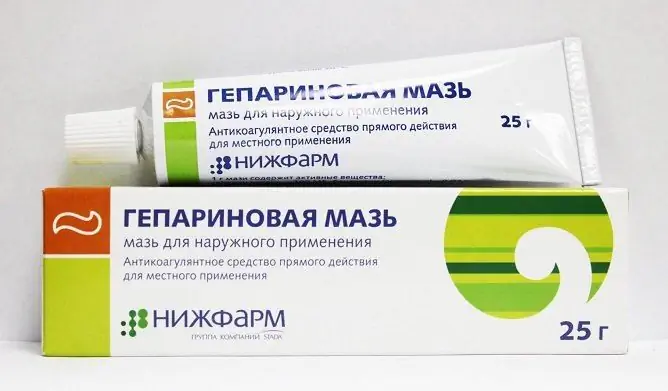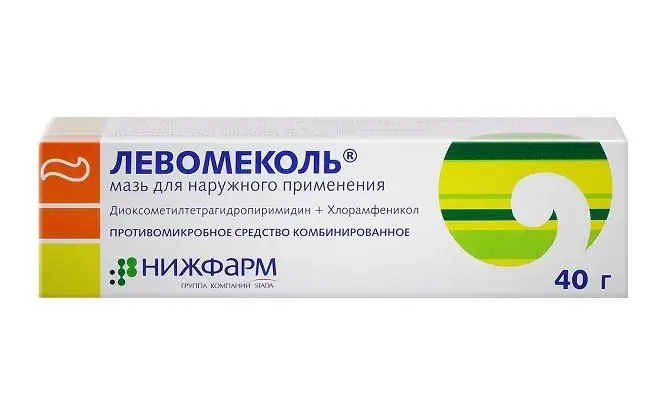- Author Rachel Wainwright [email protected].
- Public 2023-12-15 07:39.
- Last modified 2025-11-02 20:14.
Flucinar N
Latin name: Flucinar N
ATX code: D07CC02
Active ingredient: neomycin + fluocinolone acetonide (Neomycin + Fluocinolone acetonide)
Manufacturer: Elfa Pharmaceutical Plant A. O. (Pharmaceutical Works Jelfa) (Poland)
Description and photo update: 2020-25-03
Prices in pharmacies: from 183 rubles.
Buy

Flucinar N is a glucocorticosteroid drug for external use with anti-inflammatory and antibacterial action.
Release form and composition
The drug is produced in the form of an ointment for external use, which is a fat, soft mass of light yellow color, translucent in a thin layer (15 g each in aluminum tubes, in a cardboard box 1 tube and instructions for use of Flucinar N).
Composition for 1 g of ointment:
- active substances: neomycin sulfate - 5 mg (corresponds to 3400 IU of neomycin); fluocinolone acetonide - 0.25 mg;
- auxiliary components: liquid paraffin, petroleum jelly, propylene glycol, lanolin.
Pharmacological properties
Pharmacodynamics
The active substances of Flucinar N have a cumulative effect, suppressing the development of inflammatory-allergic skin reactions caused by complications due to the addition of a bacterial infection.
Fluocinolone is a potent GCS (glucocorticosteroid) for external use. It has antipruritic, anti-allergic, anti-inflammatory and vasoconstrictor activity. The mechanism of the anti-inflammatory action of fluocinolone is not fully understood. It is believed to reduce inflammation by inhibiting the synthesis of leukotrienes and prostaglandins by decreasing the release of arachidonic acid and inhibiting the activity of phospholipase A2. As a result, exudation and hyperemia decrease in the lesion focus. Fluocinolone stabilizes cell and subcellular membranes (including lysosomal membranes). This reduces the permeability of membranes and the release of proteases from lysosomes. The drug reduces the release of inflammatory mediators and the mitotic activity of cells. Fluocinolone inhibits the initial phase of inflammation,limiting his hearth. The release or synthesis of cytokines from macrophages and lymphocytes is inhibited; the severity of the immunological response in the early stages decreases.
Neomycin is an aminoglycoside antibiotic that is active against the following microorganisms:
- gram-positive cocci: Streptococcus spp., Staphylococcus spp., Enterococcus faecalis;
- gram-positive anaerobic bacteria: Actinomyces spp., Clostridium spp.;
- gram-positive aerobic bacteria: Listeria monocytogenes, Corynebacterium diphtheriae, Bacillus anthracis;
- gram-negative anaerobic bacteria: Fusobacterium spp., Leptospira interrogans;
- gram-negative aerobic bacteria: Salmonella spp., Proteus spp., Vibrio cholerae, Klebsiella pneumoniae, Pasteurella multocida, Treponema pallidum, Escherichia coli, Shigella spp., Enterobacter aerogenes, Haemophilus influenzae, Bordetella pertussis.;
- acid-fast bacilli: Mycobacterium tuberculosis;
- gram-negative aerobic cocci: Neisseria meningitidis.
Neomycin resistance develops to a small extent and rather slowly. In low concentrations, it has a bacteriostatic effect (disrupting protein synthesis in microbial cells), in high concentrations, it has a bactericidal effect (damaging the cytoplasmic membranes of microbial cells).
Pharmacokinetics
When applied externally, fluocinolone easily passes through the stratum corneum. It is not biotransformed in the skin, but accumulates in the stratum corneum. Absorption into the blood is insignificant. Absorbed fluocinolone is metabolized in the liver. It is excreted in the urine (kidneys) and bile. It is excreted unchanged and in the form of compounds with glucuronic acid.
Neomycin is able to penetrate into the deeper layers of the skin. Up to 3% of the applied dose is absorbed into the systemic circulation (this happens when the drug is used on large areas of the skin and / or for a long time). About 10% of neomycin absorbed into the blood binds to plasma proteins. It penetrates rather poorly into muscle, bone and adipose tissue, as well as into the central nervous system. Neomycin crosses the placental barrier and is secreted in breast milk. It practically does not enter the cells. Does not undergo metabolism and is excreted through the kidneys in an unchanged form. The half-life is 2 to 4 hours.
Indications for use
Flucinar N ointment is used for skin diseases complicated by a secondary bacterial infection caused by microorganisms sensitive to neomycin, namely:
- dermatitis of various etiology and pathophysiology - contact, seborrheic, atopic, allergic, solar, professional, etc.;
- eczema;
- psoriasis;
- pruritus;
- exudative erythema multiforme;
- 1st degree burns.
Contraindications
Absolute:
- tuberculosis of the skin, skin manifestations of syphilis;
- rosacea;
- diaper rash;
- anogenital itching;
- extensive psoriatic plaques;
- herpes, chickenpox;
- blastomycosis, actinomycosis;
- melanoma, atheroma, nevus;
- skin cancer;
- sporotrichosis;
- pyoderma;
- erosive and ulcerative lesions of the gastrointestinal tract;
- trophic ulcers of the leg due to varicose veins;
- open wounds in areas where the ointment is applied;
- sarcoma, hemangioma, xanthoma;
- children under 2 years of age;
- period of pregnancy;
- period of breastfeeding;
- increased individual sensitivity to the main or auxiliary components of Flucinar N.
The ointment is used with caution in patients with atrophic skin changes, especially in elderly patients.
Flucinar N, instructions for use: method and dosage
Flucinar N is intended for external use.
The ointment is applied in a thin layer to the affected skin. In adult patients, at the beginning of treatment, Flucinar N is used 2-3 times a day. Then, as the inflammation process subsides, the frequency of application is reduced to 1-2 times a day. If necessary, a bandage can be applied to the treated surface, but it must be breathable. In patients with excessive keratinization of skin areas or active scaling of the stratum corneum, the ointment can be applied under an occlusive dressing, but it should be changed every 24-48 hours.
The duration of the continuous course of treatment is a maximum of 2 weeks. The maximum daily dose is 2 g.
In children over the age of 2 years, Flucinar N is used on limited areas of the skin, no more than 1 time per day and as short a course as possible.
Side effects
The most common side effects of Flucinar H are irritation and itching. Maculopapular and nettle rashes may occur. Sometimes a secondary infection caused by bacteria that is resistant to neomycin joins the underlying disease.
With prolonged use of the ointment on the skin in the face area, steroid acne, striae, telangiectasia, perioral dermatitis, skin atrophy and depigmentation may appear. Pathological hair loss and unwanted male pattern hair growth in children and women are also possible.
When applied to large areas of the skin or prolonged treatment, systemic side effects of GCS, as well as nephrotoxicity and ototoxicity of neomycin, may develop.
Overdose
Overdose cases are extremely rare. If used incorrectly, it is possible to increase systemic adverse reactions, however, after discontinuation of Flucinar H, these phenomena disappear on their own.
special instructions
Flucinar N is not recommended for long-term use. Avoid applying the ointment to large areas of the skin. If applications are required on the skin of the face, as well as when applied to the skin in the area of folds, the course of treatment should be as short as possible.
When a secondary infection is attached, drugs with a more pronounced antifungal or antibacterial effect should be used.
Influence on the ability to drive vehicles and complex mechanisms
Flucinar N does not affect the patient's ability to drive vehicles and work with other potentially dangerous and complex machinery.
Application during pregnancy and lactation
Flucinar N ointment should not be used during pregnancy and lactation.
Pediatric use
Flucinar H should not be used to treat children under 2 years of age.
Use in the elderly
In elderly patients with atrophic changes in the subcutaneous tissue, Flucinar N is used with caution.
Drug interactions
During the treatment period, you should not plan any type of immunization, including the smallpox vaccination.
When fluocinolone is absorbed into the systemic circulation, the effectiveness of oral hypoglycemic agents and insulin, anticoagulants and antihypertensive drugs decreases; the serum concentration of praziquantel and the content of salicylates in the blood decreases.
Oral contraceptives, estrogens, androgens, and anabolic steroids increase the risk of side effects such as acne and hirsutism. The likelihood of developing undesirable side effects increases with simultaneous use with antipsychotics, cardiac glycosides, tricyclic antidepressants, diuretics and nitrates. The risk of otoxic and nephrotoxic effects increases in the case of the combined use of Flucinar H with colistin, ethacrynic acid or gentamicin.
Analogs
The analogues of Flucinar N are Hydrocortisone, Triderm, Fluorocort, Advantan, Celestoderm-V, Oxycort, Flucinar, Travocort, Panthenol, Belosalik, etc.
Terms and conditions of storage
Keep out of reach of children at a temperature not exceeding 25 ° C.
Shelf life of the ointment is 3 years.
Terms of dispensing from pharmacies
Available without a prescription.
Reviews about Flucinar N
According to reviews, Flucinar N is a fairly effective hormonal drug that quickly relieves inflammation, relieves itching, softens the skin and eliminates dryness. It helps with eczema, seborrhea, psoriasis, neurodermatitis and other skin conditions. Acts quickly, visibly improving skin condition.
Of the minuses, patients most often mention the existing contraindications and possible side effects. Ointment is hormonal and can be addictive. The cost of Flucinar N is average.
The price of Flucinar N in pharmacies
The price of Flucinar N in the form of an ointment for external use (15 g each in aluminum tubes) is 175-230 rubles.
Flucinar N: prices in online pharmacies
|
Drug name Price Pharmacy |
|
Flucinar N ointment for external use 15 g 1 pc. 183 r Buy |
|
Flucinar N ointment d / nar. approx. tube 15g 236 r Buy |

Anna Kozlova Medical journalist About the author
Education: Rostov State Medical University, specialty "General Medicine".
Information about the drug is generalized, provided for informational purposes only and does not replace the official instructions. Self-medication is hazardous to health!






